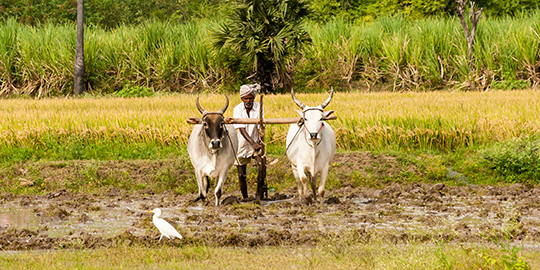
Minimum Support Prices for Kharif Crops for 2015-16 season get the nod
Source: PIB, Government of India
The Cabinet Committee on Economic Affairs, chaired by the Prime Minister Narendra Modi, has given its approval for the Minimum Support Prices (MSPs) for Kharif Crops of 2015-16 Season. The decision is based on recommendations of Commission for Agricultural Costs and Prices (CACP) for the Price Policy for Kharif Crops for the Marketing Season 2015-16. CACP takes into account the cost of production, overall demand-supply, domestic and international prices, inter-crop price parity, terms of trade between agricultural and non-agricultural sectors, the likely effect of the Price Policy on the rest of economy, besides ensuring rational utilization of production resources like land and water, while recommending MSPs. The CACP being the expert body, its recommendations are generally accepted as such. However, in view of a large surplus of cereals in contrast to huge deficit of pulses, the Cabinet made an exception and decided to give a bonus of Rs.200/- per quintal for pulses over and above the recommendations of the CACP. This is expected to give a strong price signal to farmers to increase acreage and invest for increase in productivity of pulses. (Rupees per quintal)
| Commodity | Variety | MSP for 2014-15 season (Rs. Per quintal) | MSP for 2015-16 season (Rs. Per quintal) | Increase over previous year (In Rs. Per quintal) | Bonus(In Rs. Per quintal) |
| Paddy | Common | 1360 | 1410 | 50 | --- |
| Grade A | 1400 | 1450 | 50 | --- | |
| Jowar | Hybrid | 1530 | 1570 | 40 | --- |
| Maldandi | 1550 | 1590 | 40 | --- | |
| Bajra | --- | 1250 | 1275 | 25 | --- |
| Maize | --- | 1310 | 1325 | 15 | --- |
| Ragi | --- | 1550 | 1650 | 100 | --- |
| Tur (Arhar) | --- | 4350 | 4625(includesRs.200/- Bonus) | 275 | 200 |
| Moong | --- | 4600 | 4850(includesRs.200/- Bonus) | 250 | 200 |
| Urad | --- | 4350 | 4625(includesRs.200/- Bonus) | 275 | 200 |
| Groundnut-in-shell | --- | 4000 | 4030 | 30 | --- |
| Soyabean | Black | 2500 | ---- | --- | --- |
| Yellow | 2560 | 2600 | 40 | --- | |
| Sunflower Seed | --- | 3750 | 3800 | 50 | --- |
| Sesamum | --- | 4600 | 4700 | 100 | --- |
| Nigerseed | --- | 3600 | 3650 | 50 | --- |
| Cotton | Medium Staple | 3750 | 3800 | 50 | --- |
| LongStaple | 4050 | 4100 | 50 | --- |
The prices would be effective from October 1, 2015 and would increase investment and production through assured remunerative prices to farmers. Various reports have shown that the Eastern belt of the country gets neglected in so far as procurement is concerned. Also, while the procurement mechanism is strong for rice and wheat, it needs to be improved for pulses and oilseeds. The Cabinet directed that the arrangements for procurement in the Eastern India be strengthened. The Cabinet also directed that a credible procurement mechanism for pulses and oilseeds be put in place if the need arises. Last week, a decision to import pulses was taken. These measures are expected to complement efforts to keep a check on the price rise in pulses. Besides increase in MSP, Government has taken several farmer friendly initiatives over the last one year. These, amongst other things, include the following:
- A scheme to issue Soil Health Card to every farmer has been introduced. Soil health management in the country is being promoted through setting up of soil & fertilizer testing laboratories and implementation of organic farming.
- A new scheme, Pradhan Mantri Krishi Sinchai Yojana, has been launched with the objective of creating sources of assured irrigation.
- A dedicated Kisan Channel has been started by the Doordarshan to address various issues concerning farmers.
- An initiative is being taken to set up a National Agriculture Market (NAM). This would enable farmers to overcome the impediments in marketing of agricultural produce and get better price discovery. A common e-market platform is being created and would be provided free of cost to the States/UTs.
- Government is also encouraging formation of Farmer Producer Organisations.
- To help the farmers afflicted by natural calamities, assistance was increased by 50%. Further, norms were relaxed to provide assistance to farmers who suffered a loss of 33% or more from the previous norm of 50% or more loss.
Despite deficient rainfall of 12% during Kharif during 2014-15 and unseasonal rain and hailstorm in the Rabi season, the total foodgrain production in the country has declined by only 5.3% in 2014-15. This reflects the resilience of Indian agriculture and success of their Government’s efforts in managing shortfall of rain in last kharif. This year also Government is fully prepared to meet contingency arising out of any shortfall in Monsoon. Contingency plans for 650 districts will be operationalised depending on progress of the Monsoon. ICAR, State Agriculture Universities and Department of Agriculture are working in close collaboration.
June 17, 2015 | 8:45 pm IST.






 to success.
to success.